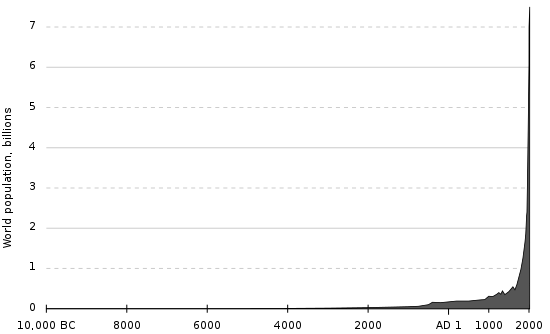I have made an interesting observation in regard to how our population has grown from a mere 4 million individuals scattered about the Earth in small communities approximately 10 thousand years ago. To now, a population over 7 billion peoples living in close proximity to each other. Additionally, upon reading our history of technological advances within those 10,000 years, it’s curious to observe how with each population explosion followed new technology that was invented and eventually shared.
.png/800px-World_population_growth_(lin-log_scale).png)

If you limit the scope of this observation to the last 200 years alone, it’s easy to see how we have more individuals able to focus on expanding our existing understanding of science and thus technology itself. As the population has consistently grown from each successive year, more people have dedicated their lives to studying one single or finite aspect of science. As that science became more mainstream and accepted by the overall population, those whom specialized in more laborious tasks requiring less education could in turn mass produce any product that resulted from previous research. Many of the technological feats we have accomplished over the last century could not have been done without the shear number of people able-bodied enough to perform the labor.
If you consider how a farmer tilled the land 50 years ago, an acre would take a full day or two for one person. But when the farmer had enough kids to help him, the same task could be done in half a day or less. With that savings in time, individuals could focus on developing hobbies and learning art, music, literature and science. As technology has progressed, technology has replaced the need for such large numbers to perform laborious tasks. So, now the single farmer can till many hectares of land in a single day with automated robotic machines.
Science has advanced to the stage where the life expectancy of children and adults has increased several folds. With each advance in medical knowledge (and subsequent sharing of that knowledge), a child born today (in a well developed country) can easily expect to live until his or her late 80’s. Comparing this to how someone born in the UK during the mid-19th century could only expect to reach about 40 to 50 years of life. Not only did the population increase with the increases in medical science, but so has the life expectancy. As living conditions and health care improved during the 19th century, the United Kingdom’s population doubled every fifty years. [44]
In today’s world, we now have the internet to share our ideas and discoveries instantly. Compare this to 50 years ago when you had to rely on a courier to hand-deliver the package/envelope. This took an extraordinary amount of time compared to today. This too, has advanced our understanding of the world and even the universe. The time it takes to make and share a discovery is significantly shorter today. These advances have lead to faster developments in technology that are ever still increasing the life expectancy of humans.

As the populations have grown, the resources available to sustain the population have decreased significantly. Again, the advances in technology have (for the time being) offset this limitation effectively “kicking the can down the road.” At some point, it’s easily foreseeable that the population will continue to outstrip the resources. Resources which are available only on limited areas of land and with even more limited access to fresh water.
Arguments and speculation aside, the positive aspect of our population is simply the large number of people that can be dedicated to a task and build or resolve large-scale complex structures and new technologies.
Further reading: http://en.wikipedia.org/wiki/Overpopulation#Effects_of_human_overpopulation
Food for thought: http://www.ted.com/talks/lang/eng/hans_rosling_on_global_population_growth.html

